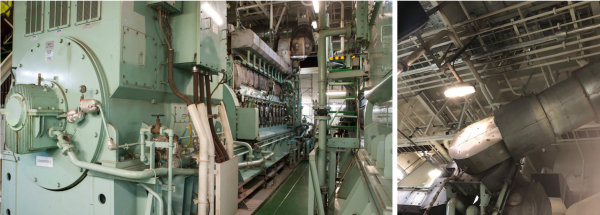Port noise management & mitigation
Mitigation and management
Under Maritime safety requirements, vessels are required to berth and depart from port with both auxiliary generators engaged for safety. Once the vessel is alongside, one generator is shut off. The running of the auxiliary generator has resulted in complaints from some vessels. Port Otago and other New Zealand ports have worked with Maersk and other shipping lines to have silencers installed on these auxiliary generators on vessels that have registered a negative monitoring score and been the subject of complaints. The monitoring of noise from the exhaust stack of vessels is undertaken from the container crane in the positions marked A, B, C and D below.
In recent years, we have undertaken several initiatives aimed at minimising noise and improving communications with our community. These include:
-
Improved noise monitoring and independent annual reviews of our noise output.
-
Use of social media to alert our community to noise-related issues, outline actions being taken to reduce the impact, and encouraging two-way dialogue.
-
Lobbying for the installation of silencers on the Rio ships. Our consultants Marshall Day Acoustics received the Australian Association of Acoustical Consultants’ 2022 Hugh Vivian Taylor Award for the effectiveness of this work.
-
Working with other ports to see the withdrawal of notoriously noisy ships from New Zealand shipping services.
-
Replacing mobile plant reversing beepers, with squawkers.
Port Otago already incorporates best practise noise management in all parts of its operation. We buy quiet, modern equipment and keep it well maintained. We also train our equipment operators on ways to reduce noise levels.
Pictured on the left is one of the two primary auxiliary generators on board each Rio vessel, it's about half the size of a large bus. The silencer, on the right, is connected directly to the generator, within a very confined and awkward space. Significant engineering work-arounds were required to make room for the silencers and manoeuvre them into their final installation point.

Port Otago noise management plan
New Zealand ports are subject to national, regional and local legislation and standards, when it comes to noise. These standards are in place to ensure the long-term compatibility of ports and their neighbours. They recognise the need for ports to operate effectively, while also providing guidelines so adjacent residential communities can co-exist alongside port activity.
The Port Otago Noise Management Plan sets out the company’s long-term commitment to assessing and managing noise from port-related activities at the Port Chalmers site. It is a living document, updated when appropriate.